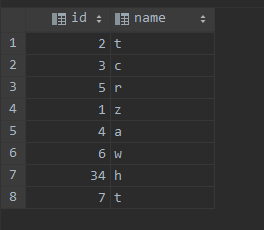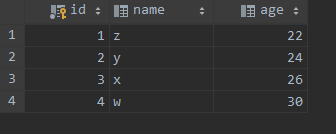
5

mysql 8.0.28 查询语句执行顺序实测结果 - 计数寄存器
source link: https://www.cnblogs.com/CounterX/p/16583776.html
Go to the source link to view the article. You can view the picture content, updated content and better typesetting reading experience. If the link is broken, please click the button below to view the snapshot at that time.

TL;NRs
根据实测结果,MySQL8.0.28 中 SQL 语句的执行顺序为:
(8) SELECT
(5) DISTINCT <select_list>
(1) FROM <left_table>
(3) <join_type> JOIN <right_table>
(4) ON <join_condition>
(2) WHERE <where_condition>
(6) GROUP BY <group_by_list>
(7) HAVING <having_condition>
(9) ORDER BY <order_by_condition>
(10) LIMIT <limit_number>
关于 SQL 语句的执行顺序,常见的是以下版本。然而该版本却与实测结果不符。
(7) SELECT
(8) DISTINCT <select_list>
(1) FROM <left_table>
(3) <join_type> JOIN <right_table>
(2) ON <join_condition>
(4) WHERE <where_condition>
(5) GROUP BY <group_by_list>
(6) HAVING <having_condition>
(9) ORDER BY <order_by_condition>
(10) LIMIT <limit_number>
MySQL 可以通过 EXPLAIN ANALYZE sql_statement 显示真实的执行过程。那么可以通过一个复杂的语句完成测试。
准备三个表 t1, t2, t3, 其中数据分别为:



执行以下语句
EXPLAIN ANALYZE
SELECT
DISTINCT COUNT(p.id) AS cnt, COUNT(e.id) AS nn
FROM t1 p
LEFT JOIN t2 q ON p.id > q.id
INNER JOIN t2 w ON q.id < w.id
RIGHT JOIN t3 e ON w.id = e.id
WHERE p.id < 10
GROUP BY p.id
HAVING cnt > 3
ORDER BY cnt DESC, nn DESC
LIMIT 1;
-> Limit: 1 row(s) (actual time=0.394..0.395 rows=1 loops=1)
-> Sort with duplicate removal: cnt DESC, nn DESC (actual time=0.393..0.394 rows=1 loops=1)
-> Filter: (cnt > 3) (actual time=0.372..0.374 rows=5 loops=1)
-> Table scan on <temporary> (actual time=0.001..0.001 rows=6 loops=1)
-> Aggregate using temporary table (actual time=0.370..0.372 rows=6 loops=1)
-> Inner hash join (e.id = w.id) (cost=4.73 rows=3) (actual time=0.314..0.324 rows=32 loops=1)
-> Table scan on e (cost=0.13 rows=5) (actual time=0.008..0.016 rows=5 loops=1)
-> Hash
-> Filter: (q.id < w.id) (cost=3.15 rows=3) (actual time=0.265..0.282 rows=32 loops=1)
-> Inner hash join (no condition) (cost=3.15 rows=3) (actual time=0.259..0.271 rows=72 loops=1)
-> Covering index scan on w using PRIMARY (cost=0.13 rows=3) (actual time=0.007..0.010 rows=4 loops=1)
-> Hash
-> Nested loop inner join (cost=2.10 rows=3) (actual time=0.084..0.232 rows=18 loops=1)
-> Filter: (p.id < 10) (cost=1.05 rows=3) (actual time=0.036..0.051 rows=7 loops=1)
-> Table scan on p (cost=1.05 rows=8) (actual time=0.034..0.046 rows=8 loops=1)
-> Filter: (p.id > q.id) (cost=0.13 rows=1) (actual time=0.021..0.025 rows=3 loops=7)
-> Covering index range scan on q (re-planned for each iteration) (cost=0.13 rows=3) (actual time=0.021..0.024 rows=3 loops=7)
这是一个调用栈,还原其执行过程为:
筛选 LIMIT 10 {
排序 ORDER BY cnt DESC, nn DESC {
调用 HAVING cnt > 3 过滤器 {
读取临时聚合表 {
聚合 {
第三次联结 RIGHT JOIN t3 e ON w.id = e.id {
扫描表 e ;
第二次联结 INNER JOIN t2 w ON q.id < w.id {
扫描表 w {
使用主键扫描
得到 4 行
}
第一次联结 t1 p LEFT JOIN t2 q ON p.id > q.id {
扫描表 p {
使用 WHERE p.id < 10 过滤器
共 8 行,返回 7 行
}
循环扫描表 q {
7 次循环 {
使用过滤器 ON p.id > q.id
}
}
执行哈希,共 21 行,返回 18 行
}
执行全连接,获得 4 * 18 = 72 行
执行 ON q.id < w.id 过滤器,剩余 32 行
}
执行相等联结 e.id = w.id, 返回 32 行
}
完成所有的联结,获得 32 行
进行聚合 GROUP BY p.id 获得 6 行
}
读取临时聚合表,获得 6 行
}
执行过滤,剩余 5 行
}
去重,剩余 2 行
排序
返回 1 行
}
输出前 1 项
}
可以看到:
- 首先进行表的扫描,也就是所谓的 FROM 第一
- 有主键的表会使用主键索引
- 有索引的表会使用索引
- 有多个表需要扫描时,根据 SQL 语句进行倒序执行
- WHERE 会在表的扫描过程中执行,也就是 WHERE 第二
- 读取到表后,会执行连接
- 有多个联结时,同样是倒序执行
- 首先执行全连接,也就是 JOIN 第三
- 全连接完成后会马上执行 ON 的过滤,也就是 ON 第四
- 完成连接后,会执行去重,也就是 DISTINCT 第五
- 完成去重后,会进行上一层的连接
- 所有连接都完成后,会执行聚合,也就是 GROUP BY 第六
- 聚合完成后,会执行一次扫描,也就是 SELECT 第七
- 扫描结束后,会执行 HAVING 过滤,也就是 HAVING 第八
- 完成过滤后,会进行排序,也就是 ORDER BY 第九
- 最后进行 LIMIT 的限制,也就是 LIMIT 第十
- 需要注意的是,LIMIT 的参数在 sort 函数的返回结果中就已经起作用,合理推测是使用的堆排序
根据实测结果,MySQL8.0.28 中 SQL 语句的执行顺序为:
(8) SELECT
(5) DISTINCT <select_list>
(1) FROM <left_table>
(3) <join_type> JOIN <right_table>
(4) ON <join_condition>
(2) WHERE <where_condition>
(6) GROUP BY <group_by_list>
(7) HAVING <having_condition>
(9) ORDER BY <order_by_condition>
(10) LIMIT <limit_number>
Recommend
About Joyk
Aggregate valuable and interesting links.
Joyk means Joy of geeK